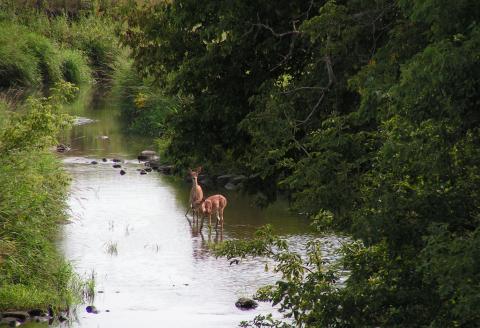
This TMDL report focuses on pollution caused by fecal coliform and E. coli. The report addresses five specific segments, or “impaired reaches,” of the main stem of the Minnesota River. The MPCA investigated bacteria levels, flow records, and water quality over time in order to develop the total maximum daily load, or TMDL, for the E. coli bacteria. The TMDL establishes the maximum amount of pollutant the waterbody can assimilate while still achieving water quality standards, and outlines what pollution reductions are needed to meet those standards.
This TMDL report addresses five aquatic recreation impairment listings for fecal coliform or Escherichia coli (E. coli) that are not already covered by an approved TMDL. These five impairments are all located within the Minnesota River Basin along the Minnesota River main stem. At a smaller scale, these five impaired stream reaches are located within these watersheds: Minnesota River Headwaters (07020001), Minnesota River – Yellow Medicine River (07020004), Minnesota River - Mankato (07020007), and Lower Minnesota River (07020012).
Allocations for load, wasteload, and margin of safety are provided in the report. The load allocation for each TMDL represents the allowable amount of loading from non-permitted sources, including unregulated watershed runoff and failing septic systems. Wasteload allocations for permitted sources are provided for wastewater, regulated stormwater, and permitted animal feeding operations. Water quality data were compared with the water quality standard to estimate reduction needs. Reductions needed to meet the TMDLs range from 19% to 60%.
This report also includes an implementation strategies section to substitute for a separate strategies report. The implementation strategy prioritizes geographic areas for implementation and provides a description of management activities to reduce E. coli loading from permitted sources and the non-permitted sources identified as high priority sources—livestock and failing septic systems. The goal of the strategies is to restore impaired streams and protect unimpaired streams from impairment.
Strategy development for restoration and protection
-
(EPA approval 6/11/2019)
Project area
The Minnesota River begins near the Minnesota-South Dakota border, flowing for 335 miles before joining the Mississippi River near St. Paul. The basin includes all or parts of 37 counties, draining a 17,000-square-mile area. The river and its tributaries provide important economic, ecological, recreational, and cultural benefits.